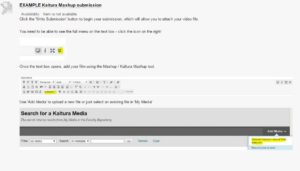In 2010, Roshni Khatri presented on students perceptions of online audio and online text based feedback. Her experiences on feedback were also further disseminated in the Submission and Grading Electronically (SaGE) working group on 17th December, 2014 as they were felt to be still relevant to current cohorts.
Roshni indicated that the majority of students preferred the audio feedback when compared to the online feedback.
Students commented that:
- ‘The online written feedback was visual and suits my learning style.’
- ‘I heard my name and I paid attention!’
- ‘really helpful for me as I am able to go over the proposal and know which bits you are explaining about. I find this more helpful than having written feedback.’
The presentation noted benefits and problems with the process and made suggestions for further work.
 Although we suggest using the Media Gallery on NILE for students to submit work to, there are a couple of drawbacks. You would need to add feedback and marks through a Grade Centre column and students cannot see their submitted work in the media gallery, which has led to a few anxious calls to the LearnTech helpdesk.
Although we suggest using the Media Gallery on NILE for students to submit work to, there are a couple of drawbacks. You would need to add feedback and marks through a Grade Centre column and students cannot see their submitted work in the media gallery, which has led to a few anxious calls to the LearnTech helpdesk.
The alternative is to use a standard Blackboard Assignment (not Turnitin) and allow students to use the Kaltura Mashup tool – which is part of the text box editor. This creates a Grade Centre column and students will have more confidence that they have submitted their work.
It does require clear guidance though so we have created a basic explanation (with screenshots that will work in any module), that you can paste into the description text box (use the HTML editor) to get you started.
You may be having trouble getting Kaltura screen recorder to work. It turns out that with the latest version of Java as a security feature, applets get blocked if their HTML source and jar file are on different servers. To overcome this, you need to add an exception for both https://nile.northampton.ac.uk/ and https://cdnsecakmi.kaltura.com – this does do the trick! The link below explains it in detail: http://www.java.com/en/download/help/java_blocked.xml (Thank you to Dr.Hendrix, for tracking down this solution).
How does it work on a mac? It appears to VERY picky about browser, OS and java versions. We got it to work in Safari on OSX v10.9.3 with Java 7 – running the NILE site in “Unsafe mode” by going to Safari Preferences > Security > Manage Website Settings > Select Java from the left and selecting ‘Run in unsafe mode’ for nile.northampton.ac.uk. Not ideal, but until Kaltura and the latest version of Java are in synch, it is at least possible to get it to work.
Please contact IT Services (rather than LearnTech) on ext. 3333, if you need to get this working on a uni machine.
Images and interactivity encourage students to explore content more willingly that a list of links and anything that can facilitate students to generate and share content themselves outside of the rather clunky discussion boards and blogs within NILE is always welcome.
thinglink is a free picture annotation tool website that allows content to be linked to external resources and then be embedded in your NILE site or blog. There are also editors available as IOS or Android apps.
Possible uses are as a ‘visual portal’ for students to access further information and resources or – if the thinglink is set to public – as a shared activity where students can add links and annotations to a picture as a class or as part of a group.
You can find more details and try using example thinglinks in this NILEX review.
Thanks to Belinda Green for spotting the usefulness of this app in Education and sharing.
 We’re well into assignment season and support calls are beginning to increase in relation to missing assignment submission points, incorrect settings preventing students from uploading one or more versions, apparently missing assignment submission in Grade Centre, grades being released too early (or never) and scores instead of letter grades being given to students.
We’re well into assignment season and support calls are beginning to increase in relation to missing assignment submission points, incorrect settings preventing students from uploading one or more versions, apparently missing assignment submission in Grade Centre, grades being released too early (or never) and scores instead of letter grades being given to students.
While it might be tempting to blame the computer*, it’s usually just being a little rusty that’s at the root of the problem. Please take a few minutes to remind yourself of the simple things to do before and after marking to avoid problems by looking at the SaGE survival guide.
NILE isn’t without its problems, but we must be honest with students if we are to be able to interpret their feedback on this critical part of their student experience.
* and posting this in an announcement!
 Great learning design and quality assurance are two sides of the same coin. When you make changes to a module or programme, there are a range of QA procedures that might apply, and it helps to understand how these processes interlink – particularly when planning ahead.
Great learning design and quality assurance are two sides of the same coin. When you make changes to a module or programme, there are a range of QA procedures that might apply, and it helps to understand how these processes interlink – particularly when planning ahead.
New programmes or modules
When writing a new module or programme, a CAIeRO workshop can help you with everything from writing the learning outcomes, to choosing the assessment and creating the learning activities. The first day of the workshop will help you set the foundations, and the second day helps ensure these are workable in practice.
New programmes and modules are subject to validation, and as part of this process you will be required to write a rationale for the new offering. The planning work you do in the CAIeRO can help you complete this, as it includes consideration of strategic goals, the student experience, and resource and training requirements. The CAIeRO process can also help you firm up your curriculum documentation (also required for validation), and make decisions about the allocation of teaching and learning hours, assessment strategy and more. In addition to documentation, the CAIeRO can help you get started creating sample teaching materials, which are required for validation of distance learning programmes.
At the University, many validations can be completed online, but some (particularly those involving PSRBs) require a validation event. For these programmes, validations usually take place in the Spring term. For a new programme starting in September, you should aim for validation early in the term to allow the maximum possible time for development of the course materials (if you want the course to start the following January, you might aim for validation later, in March or April). This means you should be scheduling your CAIeRO in the previous Autumn term.
For more on the validation process, see the validation page of the website, which has information and links to the handbook..
Periodic subject reviews
 PSRs are a chance to reflect on what has worked well in your teaching over the previous five years. It is also a great opportunity to use those reflections to define the future direction of the programmes involved. The CAIeRO process can be used to support this process in a number of ways: as a ‘health check’ or review of a programme; to target specific issues you may have identified; and/or to plan how to implement changes you’d like to make.
PSRs are a chance to reflect on what has worked well in your teaching over the previous five years. It is also a great opportunity to use those reflections to define the future direction of the programmes involved. The CAIeRO process can be used to support this process in a number of ways: as a ‘health check’ or review of a programme; to target specific issues you may have identified; and/or to plan how to implement changes you’d like to make.
For PSR you will be required to submit a Self-Evaluation Document (SED). This document will ask you to reflect on things like alignment with frameworks and standards, the currency of the curriculum and student achievement and feedback. All of these elements can be considered within the CAIeRO process, to help you complete the SED form and prepare for any questions during the PSR event.
At the University, PSRs usually take place in the Autumn term, and the documentation is submitted in advance. CAIeROs for PSR can be scheduled at any point in the year (although you may want to note the Change of Approval guidance below when considering timing).
For more on the PSR process, see the PSR page on the website, which has information and links to the handbooks.
Ongoing review of delivery
 Of course, adjusting and adapting your teaching and assessment practice happens all year round, and is not dependent on big events like those listed above. You might have taken over a module or programme, or be considering a more blended approach, or just want to try a new idea you’ve heard about. You can book a CAIeRO for issues like this at any time in the year, but you should be conscious of timing the implementation of these changes, and the possible impact on the student experience.
Of course, adjusting and adapting your teaching and assessment practice happens all year round, and is not dependent on big events like those listed above. You might have taken over a module or programme, or be considering a more blended approach, or just want to try a new idea you’ve heard about. You can book a CAIeRO for issues like this at any time in the year, but you should be conscious of timing the implementation of these changes, and the possible impact on the student experience.
Wherever possible, you should avoid making big changes that will affect current delivery of a module or programme part way through. In addition to this, for level 5 and 6 modules, be aware that students need to know what to expect when they make their module choices. Any changes made after students have chosen the module should be made in consultation with those students.
Changes to existing modules and programmes are achieved through the Change of Approval process, which recognises three levels of change (based on degree of impact). Type B and C changes (more substantial than Type A) must be submitted well in advance of the proposed delivery, and for levels 5 and 6, in advance of the publication of module information to students. For 2015/16 delivery, the deadline for change of approvals for these modules is 13 January (for levels 4 and 7, the deadline is May).
For more on this process, see the Change of Approval page on the website, which has information and links to the handbooks.
 Learntech have been examining the world of free online polling tools this week in response to a number of requests. While there are several alternatives with different strengths an weaknesses, Polldaddy stands out as a flexible tool to use in a variety of situations – as a brief informal piece of formative assessment, a survey/poll or just feedback on a piece of content or activity. These items embed very well within NILE. There is a fuller description of Polldaddy on the NILE External Tools blog.
Learntech have been examining the world of free online polling tools this week in response to a number of requests. While there are several alternatives with different strengths an weaknesses, Polldaddy stands out as a flexible tool to use in a variety of situations – as a brief informal piece of formative assessment, a survey/poll or just feedback on a piece of content or activity. These items embed very well within NILE. There is a fuller description of Polldaddy on the NILE External Tools blog.
It requires an email registration on the WordPress.com site, with which it is also tightly integrated.
 Although Staff have access to Panopto to record their presentations, students have had to do things like embedding audio into PowerPoint to create multimedia presentations until now.
Although Staff have access to Panopto to record their presentations, students have had to do things like embedding audio into PowerPoint to create multimedia presentations until now.
SlidesLive can work in a very similar way to Panopto – download the recording software (for Mac and Windows), record the presentation, upload it and make some editing changes. It is slightly different in that it converts each slide to an image, the advantage being that it’s possible to replace or remove a slide using the online editor. It’s also possible to add a second ‘stream’ by using a video clip from YouTube that can be viewed alongside the slide images – the viewer can adjust the relative sizes of those two pictures.
There’s nothing to stop you adding a YouTube video directly in the online editor, then adding a number of images (these could be captions or even a transcript) which you can synchronise to the video. You’re not obliged to just capture PowerPoint, the recording of the slides is just a screen capture, so you can use other presentation software or just capture a screen (just one screen if you have two).
In its simplest form, most students would have very little difficulty in creating a basic presentation. The down side is that although uploaded presentations can be made unlisted, they cannot be downloaded so are unsuitable for summative assessments. However, presentations can be made public, perhaps as part of a portfolio or an online CV. The slide/video combination also opens up the possibility of more creative uses – critiquing someone’s video presentation or interpreting the content. 
You can find a video/slides example here. SlidesLive does require users to register using a simple email – as ever, we’d suggest avoiding the Facebook login option.
 In 2003, Richard Winter wrote a piece for the Guardian in which he listed some problems than can occur when essays are the primary tool used to assess what, and how much, students have learned. Winter claimed that the essays students write often show evidence only of surface learning, rather than deep learning, and that the use of essays for assessment was partly to blame for this. Personally speaking, I really like the essay. I find it stimulating, challenging, and an opportunity to examine and learn in great detail and depth. However, regardless of how much one might like the essay, sometimes it could be useful to provide students with a friendly way in to academic writing, especially for first-year undergraduates or those returning to education after a break, and this is where patchwork text assessment comes in.
In 2003, Richard Winter wrote a piece for the Guardian in which he listed some problems than can occur when essays are the primary tool used to assess what, and how much, students have learned. Winter claimed that the essays students write often show evidence only of surface learning, rather than deep learning, and that the use of essays for assessment was partly to blame for this. Personally speaking, I really like the essay. I find it stimulating, challenging, and an opportunity to examine and learn in great detail and depth. However, regardless of how much one might like the essay, sometimes it could be useful to provide students with a friendly way in to academic writing, especially for first-year undergraduates or those returning to education after a break, and this is where patchwork text assessment comes in.
The basic idea is that rather than choosing one or two major points of assessment, the students submit multiple short pieces of writing on a regular basis (perhaps in the form of an academic blog or journal) which are then ‘stitched together’ with a final summary, evaluation or reflective commentary. The learning outcomes remain the same, the word count is not altered, and the final submission deadline stays as it is: the difference is that the writing is built up over a longer period of time, in which the students complete many short, directed writing tasks. The writing tasks could be similar or varied, and could be shared for peer-review or kept private. Tutors could review the writing tasks at one or two specific intervals in order to provide formative feedback, or could simply mark everything at the end of the process.
Dr. Craig Staff (Senior Lecturer in Fine Art) and Rob Farmer (Learning Designer) are currently conducting research into patchwork text assessment with students in the School of The Arts. The purpose of the research is to study the attitudes of students to this type of assessment, to look at the quality of the writing they produce, and to determine the staff workload implications when assessing the patchwork texts. The project is due to run over three academic years (2013/14, 2014/15, 2015/16), and will involve around 300 students from levels four to six. Interim findings from the students who undertook the patchwork assessments in 2013/14 clearly showed that it would be worthwhile continuing with the project.
Find out more …
Read Richard Winter’s 2003 Guardian article ‘Alternative to the Essay’
Visit the patchwork text pages of Richard Winter’s website
Visit the Digitally-enhanced Patchwork Text Assessment (DePTA) JISC project website
 Thursday the 23rd of October saw the appearance of the Follow Northampton app in the App Store. The app is a freely available interactive guide to Northampton, and it offers a fresh perspective on Northampton’s rich historical, architectural and cultural heritage. The app, and the associated website, were created and developed by staff and students at the University of Northampton and members of the wider Northampton community. The project leads were Dr. Drew Gray, Senior Lecturer in History, and Sabine Coady Schaebitz, Director of the Collaborative Centre for the Built Environment. Technical support and advice was provided by Rob Farmer from the Learning Technology Team, and the app was built by Chris Collinge from wedoApps. Content was developed by BA History students (Roseanne Belcher, Gabrielle Cairns, Jasdeep Dhillon and Steve Robinson), photographs were provided by a BA Photography student (Peter Holmes), and audio recordings were made of a number of (actual and honorary) Northamptonians, particularly Peter Aiers, Andy Clarke, Peter James Norman, Professor Nick Petford, and Dr. Toby Purser.
Thursday the 23rd of October saw the appearance of the Follow Northampton app in the App Store. The app is a freely available interactive guide to Northampton, and it offers a fresh perspective on Northampton’s rich historical, architectural and cultural heritage. The app, and the associated website, were created and developed by staff and students at the University of Northampton and members of the wider Northampton community. The project leads were Dr. Drew Gray, Senior Lecturer in History, and Sabine Coady Schaebitz, Director of the Collaborative Centre for the Built Environment. Technical support and advice was provided by Rob Farmer from the Learning Technology Team, and the app was built by Chris Collinge from wedoApps. Content was developed by BA History students (Roseanne Belcher, Gabrielle Cairns, Jasdeep Dhillon and Steve Robinson), photographs were provided by a BA Photography student (Peter Holmes), and audio recordings were made of a number of (actual and honorary) Northamptonians, particularly Peter Aiers, Andy Clarke, Peter James Norman, Professor Nick Petford, and Dr. Toby Purser.
The app and website were made possible by the award of a Learning Enhancement & Innovation Grant from the University of Northampton. And the great news is that work on the app and the website is set to continue, as a second Learning Enhancement & Innovation Grant was recently given, and this will allow the project to cover more locations, and will allow the inclusion of extra features into the app. We are hoping to launch a second version of the app in March 2015, which will include full offline access to the locations, improved navigation, and additional locations. A third version is planned for July 2015 which will include design and layout updates, the addition of social media sharing options, and even more locations. In the longer term, we hope to add videos, iBeacons, and augmented reality, and to make an Android version of the app.
Get the iOS app: https://itunes.apple.com/gb/app/follow-northampton/id919466161?mt=8
Visit the website: http://www.follownorthampton.co.uk
Recent Posts
- Blackboard Upgrade – December 2025
- Preparing for your Physiotherapy Apprenticeship Programme (PREP-PAP) by Fiona Barrett and Anna Smith
- Blackboard Upgrade – November 2025
- Fix Your Content Day 2025
- Blackboard Upgrade – October 2025
- Blackboard Upgrade – September 2025
- The potential student benefits of staying engaged with learning and teaching material
- LearnTech Symposium 2025
- Blackboard Upgrade – August 2025
- H5P (HTML5 package) content types meets the needs of Jim Atkinson, Staff Development Trainer
Tags
ABL Practitioner Stories Academic Skills Accessibility Active Blended Learning (ABL) ADE AI Artificial Intelligence Assessment Design Assessment Tools Blackboard Blackboard Learn Blackboard Upgrade Blended Learning Blogs CAIeRO Collaborate Collaboration Distance Learning Feedback FHES Flipped Learning iNorthampton iPad Kaltura Learner Experience MALT Mobile Newsletter NILE NILE Ultra Outside the box Panopto Presentations Quality Reflection SHED Submitting and Grading Electronically (SaGE) Turnitin Ultra Ultra Upgrade Update Updates Video Waterside XerteArchives
Site Admin


